Getting started stage 1 of 3
Hand strength, grasp development through play
Play dough / Theraputty– rolling, pinching, squeezing, pulling – encouraging him to squeeze together using one hand, retrieving pegs, small objects and placing into a container. Use a rolling pin to roll playdoh flat and cut out shapes using biscuit or animal cutters.
Tweezer games – operation, bed bugs, crocodile teeth, avalanche fruit salad, feed the animals
Tweezer activities – sorting objects / balls into colours, numbers, sorting into containers, using tweezers to pull out beads
Construction Toys: Lego, kid n knex, magnetics, puzzles, marble runs.
Squeeze clothes pegs or spring loaded paper clamps onto pieces of cardboard to make pictures
Roll play dough / space putty and push straws or cocktail sticks to make a hedgehog
Matching games using pegs
Using pegs for learning games e.g sums on the pegs and attach to the correct card, or place the number of pegs on the card, colour match pegs with cards, place words onto pegs and use the too clip onto card to make a sentence, follow a sequence pegging the pattern along the line using pegs to secure it.
Please also see out pencil skills advice sheet for further activity ideas and out fine motor skill advice sheet.
Next Steps 2 of 3
Pencil grasp development
As children develop their pencil grasps change:
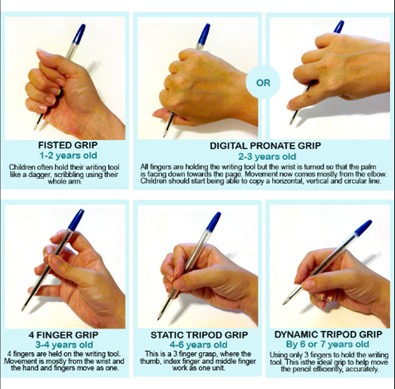
Most children naturally develop a pencil grasp that is comfortable for them and a variety of different grasps can be seen in any classroom. A pencil grasp only becomes a problem if the child complains of fatigue, pain in their hand, or has difficulty writing neatly and at a reasonable speed (as compared to their peers).
The most efficient grasps are the dynamic tripod and dynamic quadrapod (see below).
Right hand:
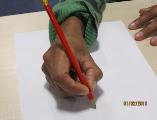
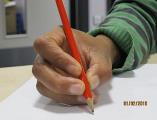
Left hand:
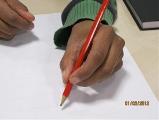
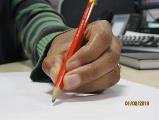
An awkward or unusual pencil grasp becomes more difficult to change as a child gets older; therefore it is important to encourage your child to hold their pencil with a grasp that:
- Positions the pencil between the thumb, index and middle fingers.
- Has the ring and little finger bent and resting comfortably on the table.
- Has the thumb and index finger forming an open space.
- Has the wrist extended slightly and the forearm resting on the table.
- Holds the pencil approximately 1-2cm from the tip.
- Allows their hand and fingers to move when writing and drawing.
Getting There 3 of 3
Helpful strategies
- Show your child how to hold the pencil and help them to place their fingers and thumb correctly.
- Give your child feedback to help them become aware of their finger and thumb positions and praise them whenever they demonstrate a suitable pencil grip.
- Give your child pencils/crayons approximately 5cm long to encourage them to use a tripod grasp.
- Encourage your child to do lots of fun and interesting drawing and writing activities using different types of pens, coloured pencils, crayons and chalks so they are motivated to practice.
- Use an angled writing board to encourage correct wrist position and support their arm.
|
Difficulty:
|
Pencil Grip Recommendations:
|
|
Hand Pain/Reduce Tension
|
- Wishbone grip Penagain
- Kush n Squish sensory grip
- Ridged comfort grip
- Ball development grip
- Jumbo ultra grip
- Comfort foam grip
|
|
Finger Positioning
|
- Wrap pencil grip
- Stabilo EasyErgo pencil
- Tri-go Grip
- Stabilo easy original pen
- Mini Stubbi Grip
- Wishbone Grip Penagain
- Claw grip
|
|
Sensory stimulation
|
- Kush n Squish sensory grip
|
|
Improving grasp
|
- Handiwriter
- Standard Triangular Grip
|